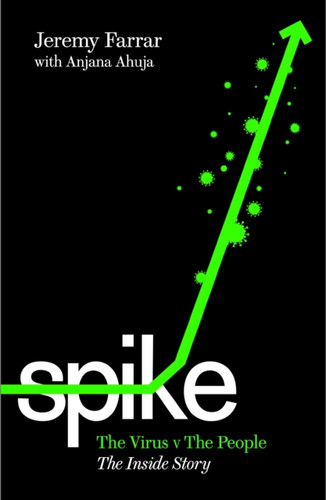Write a Review

Spike 9781788169226 Hardback
-
Book review of Spike by Jeremy Farrar and Anjana Ahuja
Unputdownable is an awkward neologism, but it describes this book perfectly. I read the 231 pages in 24 hours, rushing through meals to reach the conclusion. Fortunately, I have time on my hands, having recently retired from a career in medical virology. This novel, co-written by the Director of t…
Unputdownable is an awkward neologism, but it describes this book perfectly. I read the 231 pages in 24 hours, rushing through meals to reach the conclusion. Fortunately, I have time on my hands, having recently retired from a career in medical virology. This novel, co-written by the Director of the Wellcome Trust and the science columnist for the Financial Times, imagines a dramatic scenario where a new virus, like the sun, appears in the East and spreads rapidly throughout the world. Time-honoured isolation of cases and quarantine are deployed promptly in some countries, but not in others. A pandemic is declared. As the death rate climbs, international travel plummets and economic activity around the world is greatly reduced. The question of the origins of this new virus moves from being a scientific puzzle to various beliefs owned and weaponized by politicians. The protagonist consults an ex-head of MI5 and invests in a burner phone to avoid surveillance. Despite failing to follow scientific advice to cut short the first wave, politicians do not learn and again ignore uncomfortable truths, precipitating a second, larger, wave of infections involving tens of thousands of preventable deaths. At last, the cavalry arrives in the form of vaccines made in record time using novel technology. As a clear pathway emerges out of the pandemic, the politicians then fight with each other over vaccine supply for wealthy countries while ignoring the needs of those countries with less financial muscle. Have I left anything out? Oh, yes; I forgot to mention that the dystopian saga described by the authors is not a figment of their imagination, but an all too true story. I was able to check many facts and dates as I went along from the notes I made for my own novel set during the pandemic and can confirm that all depictions are accurate. Spike contains important scientific principles, but these will be absorbed easily, as if by osmosis, by those without formal training in science, medicine or mathematics, aided by a glossary of terms used. The listing of Dramatis personae is also worth reading. The book is strongest when calling for international collaboration and financial investments to reduce the impact of future pandemics, including the announcement of a future Global Pandemic Radar. I have one quibble and one minor error that should be corrected in the next edition. On page 94 the authors say “There is, however, no precedent in the modern era for populations achieving herd immunity to a novel disease through natural infection.” This is incorrect, because introduction of measles into island communities without a history of prior infection leads to extensive transmission followed by disappearance of the virus despite not all islanders being infected. This is explained by herd immunity as is the periodicity of epidemics of measles that infects so many individuals that infection cannot be sustained until a few generations of newborn babies grow up to provide sufficient new susceptibles for the next epidemic. The minor error is on page 190 where the authors discuss mRNA vaccines: “This genetic code is piggy-backed into the body inside an envelope of lipids (proteins), where the body’s own cells read the code and generate the corresponding protein.” Lipids are not proteins, but the “(proteins)” was presumably an aide memoire to the authors to explain about the code, which they then forgot to delete. Who is the target audience for Spike? As I read it, I was transported back to my youth when I read The Day of the Jackal and marvelled that a fictitious story could revolve around a real person, even a prominent politician. This aspect was reinforced by the authors committing nearly a third of the text to discussing various theories for the evolution of the virus, including whether it was man-made, together with accompanying geopolitical implications. As well as impressionable adolescents, Spike should be read by any adult interested in how the pandemic was handled by our political masters. Finally, Spike will be of most benefit to the current cadre of politicians who may “think the people of this country have had enough of experts,” yet have a lot to learn. Their breezy make-it-up-as-you-go-along philosophy of life, coupled with narcissism and duplicity has met its match in a tiny, but relentless, force of nature; a supremely efficient demonstrator of survival of the fittest called a virus. Paul Griffiths Emeritus Professor of Virology, UCL (Submitted on 1 August 2021)
- Authors:
- Farrar, Jeremy|Ahuja, Anjana (Science Writer)
- Year Published:
- 2021
- Country of Publication:
- United Kingdom
- Format:
- Hardback
- ISBN:
- 9781788169226
- Number of Pages:
- 272
- Publication Date:
- 22/07/2021
- Publisher:
- Profile Books Ltd
- Imprint:
- Profile Books Ltd
- Place of Publication:
- London
- SKU:
- 9781788169226

